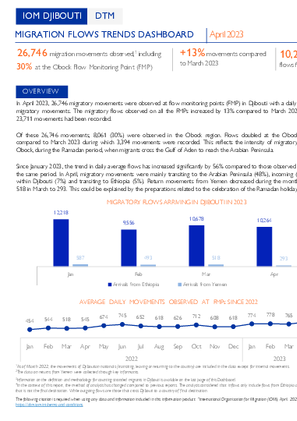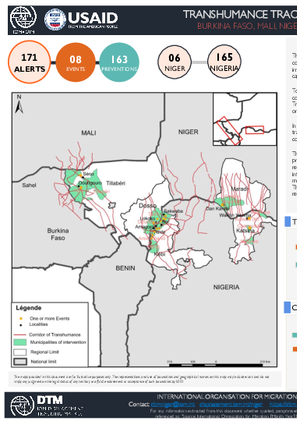-
Countries
-
Data and Analysis
-
Special Focus
-
Crisis Responses
Contact
dtmlibya@iom.int
Location
Libya
Activity
- Mobility Tracking
- Baseline Assessment
Period Covered
Jan 01 2023 -Feb 28 2023
A baseline assessment is a sub-component of mobility tracking. It aims to collect data on IDP, migrant or returnee population presence in a defined administrative area of the country.
Population Groups
Survey Methodology
Unit of Analysis Or Observation
Type of Survey or Assessment
Keywords
Geographical Scope
Administrative boundaries with available data
The current dataset covers the following administrative boundaries

Contact
DTM Libya, DTMLibya@iom.int
Language
English
Location
Libya
Snapshot Date
Feb 28 2023
Activity
- Flow Monitoring
- Mobility Tracking
- Baseline Assessment
This infographic presents the key findings of Round 46 of the mobility tracking component of the Displacement Tracking Matrix (DTM) programme in Libya.

Contact
DTM Libya, DTMLibya@iom.int
Language
English
Location
Libya
Period Covered
Jan 01 2023
Feb 28 2023
Activity
- Mobility Tracking
- Baseline Assessment
IOM Libya’s Displacement Tracking Matrix (DTM) programme identified a total of 706,062 migrants from over 44 nationalities in the 100 Libyan municipalities during round 46 of data collection (January - February 2023). The number of migrants in Libya has continued to increase slightly compared to the previous round of data collection (694,398 migrants, Round 45, November – December 2022).
Contact
DTM Sudan, dtmsudan@iom.int
Location
Sudan
Activity
- Mobility Tracking
- Baseline Assessment
Period Covered
Apr 15 2023 -May 21 2023
A baseline assessment is a sub-component of mobility tracking. It aims to collect data on IDP, migrant or returnee population presence in a defined administrative area of the country.
Population Groups
Survey Methodology
Unit of Analysis Or Observation
Type of Survey or Assessment
Keywords
Geographical Scope
Administrative boundaries with available data
The current dataset covers the following administrative boundaries

Contact
DTMUkraine@iom.int
Language
English
Location
Ukraine
Snapshot Date
Apr 30 2023
Activity
- Baseline Assessment
Базове територіальне оцінювання зареєстрованих ВПО надає детальні дані щодо кількості та географічного розташування офіційно зареєстрованих внутрішньо переміщених осіб (ВПО). У звіті оцінюється присутність зареєстрованих ВПО на рівні району, а також відображаються зафіксовані зміни, що сталися за період з попереднього раунду. У 23 раунді представлені дані щодо зареєстрованих ВПО, розподілені за статтю та віком, а також їхній розподіл на три конкретні вікові групи.

Contact
DTM Djibouti, DTMDjibouti@iom.int
Language
English
Location
Djibouti
Period Covered
Apr 01 2023
Apr 30 2023
Activity
- Flow Monitoring
En avril 2023, 26 746 mouvements migratoires ont été observés aux points de suivi des flux (FMP) à Djibouti avec une moyenne quotidienne de 892 mouvements migratoires. Les flux migratoires observés sur l’ensemble des FMP ont augmenté de 13% par rapport à mars 2023 au cours duquel 23 711 mouvements avaient été enregistrés.

Contact
DTM Djibouti, DTMDjibouti@iom.int
Language
English
Location
Djibouti
Period Covered
Apr 01 2023
Apr 30 2023
Activity
- Flow Monitoring
In April 2023, 26,746 migratory movements were observed at flow monitoring points (FMP) in Djibouti with a daily average of 892 migratory movements. The migratory flows observed on all the FMPs increased by 13% compared to March 2023 during which 23,711 movements had been recorded.

Contact
DTM Sudan; dtmsudan@iom.int
Language
English
Location
Sudan
Snapshot Date
May 21 2023
Activity
- Mobility Tracking
- Event Tracking
From 15 April 2023, armed clashes erupted between the Sudanese Armed Forces (SAF) and the Rapid Support Forces (RSF) in multiple cities across Sudan, including Khartoum, Al Fasher, Kebkabiya, Merowe, Nyala, Zalingi, Ag Geneina, and El Obeid. DTM Sudan has been receiving reports of widespread displacement across different states in Sudan due to the ongoing security situation.
- Since 15 April 2023, DTM estimates that approximately 1,042,114 individuals (209,136 households) have been displaced internally as a result of the conflict.
- Notably, the current estimate for displacement since the conflict began is comparable to that recorded by DTM Sudan for all displacement from 2020 through 2022.
- Furthermore, an estimated additional 319,194 individuals have crossed into neighbouring countries.
Due to the ongoing nature of the fighting, many areas reportedly remain inaccessible to humanitarian actors. DTM estimates of displacement are based on preliminary reports from field teams and should be taken as estimations only. Additional reports of displacement are likely to emerge as the situation becomes clearer.
Locations of displacement have been reported in 17 of Sudan’s 18 states. Namely, these include the states of Khartoum, Northern, River Nile, Aj Jazirah, North Kordofan, South Kordofan, West Kordofan, White Nile, Sennar, Blue Nile, North Darfur, South Darfur, West Darfur, Central Darfur, Kassala, Gedaref, and Red Sea.
Disclaimer: DTM Sudan notes that military clashes remain continuous in many areas across Sudan in particular in Khartoum and the Darfur region – limiting humanitarian access. Additionally, field teams have reported severe telecommunication and connectivity issues, as well as escalating economic pressures which have impacted the capacity for domestic travel. As such, DTM is currently conducting remote interviews with key informants across its network and is currently unable to engage in the additional verification of these figures. Data on flows into neighbouring countries is based on available information from DTM flow monitoring networks and secondary sources.

Contact
DTM Malawi, DTMMalawi@iom.int
Language
English
Location
Malawi
Period Covered
Mar 31 2023
Apr 27 2023
Activity
- Mobility Tracking
- Baseline Assessment
This report provides an overview of Round 1 of IOM's Multi-Sectoral Location Needs Assessments of the different IDP sites in Malawi. More details for each site are available through the published report viewable here.
Cyclone Freddy made landfall in Malawi’s Southern Region on 12 March 2023, bringing torrential rainfall, and causing devasting floods and mudslides in Southern Malawi. Assessments are still ongoing, led by the Department of Disaster Management Affairs (DoDMA) but critical infrastructure (roads, houses and hospitals) have been damaged or destroyed. As of 20 March 2023, DoDMA estimates over 508,000 people have been displaced across Nsanje, Chikwawa, Phalombe, Mulanje, Blantyre, Thyolo, Chiradzulu, Blantyre City, Mangochi, Machinga and Balaka districts. An estimated 534 evacuation centers/Internally Displaced People (IDP) sites have been established with over 70 per cent of the IDPs being hosted in public buildings such as schools and churches. The Government of Malawi (GoM) announced a state of disaster in 14 districts on 13 March in response to the floods and landslides, and rescue teams were deployed to the affected areas to provide humanitarian assistance to those most affected. IOM deployed teams on 3 April to conduct a Multi-Sectoral Location Assessment (MSLA) at camp/collective sites level to assist the Government and partners with their response efforts. The first update of the report covers the 168 sites assessed from 31 March - 27 April and provides a snapshot of the current number of displaced households and persons residing in the worst affected three districts (Nsanje, Chikwawa and Blantyre). The assessments also provide an overview of the types of IDP sites, NFI needs, intentions, services provided and other key information.

Contact
DTM Niger, NigerDataResearch@iom.int, RODakar-DataResearch@iom.int
Language
English
Location
Niger
Period Covered
Jan 01 2023
Feb 28 2023
Activity
- Other
The transhumant livestock system is an ancient practice of migratory pastoralism between Sahelian countries towards coastal ones. These Sahelian countries are faced with vulnerability factors (security crisis, irregular rainfall, competition over natural resources) that threaten their sustainability, weaken their capacity to adapt and provoke tensions between communities that sometimes result in deadly conflicts.
To better understand transhumance movements trends and the impact of vulnerabilities on transhumant communities, IOM has developed the Transhumance Tracking Tool (TTT) through its Displacement Tracking Matrix DTM, with the Bilital Maroobe Network (RBM) and its “members, the pastoralist organisations”, to monitor transhumance in cross-border areas in countries where RBM operates.
In the framework of this project, the TTT provides an understanding of the dynamics of cross-border transhumance between Burkina Faso, Niger, Nigeria and Mali by combining three components: mapping, counting and alerting.
The purpose of the alert system is to identify events related to the use of natural resources, agro-pastoral practices, and disasters in the cross-border area of different countries, to understand existing conflict resolution methods, and to inform competent authorities to reduce tensions in the municipalities of intervention. This system makes it possible to identify alerts related to a conflict event (event alert) or to a massive, early, late or unexpected movement of livestock (prevention alert) that could lead to conflict. These alerts, once transmitted to the various actors, are used for conflict prevention or actions towards resolutions. This report presents data from the alert tool for the months of January to February 2022
